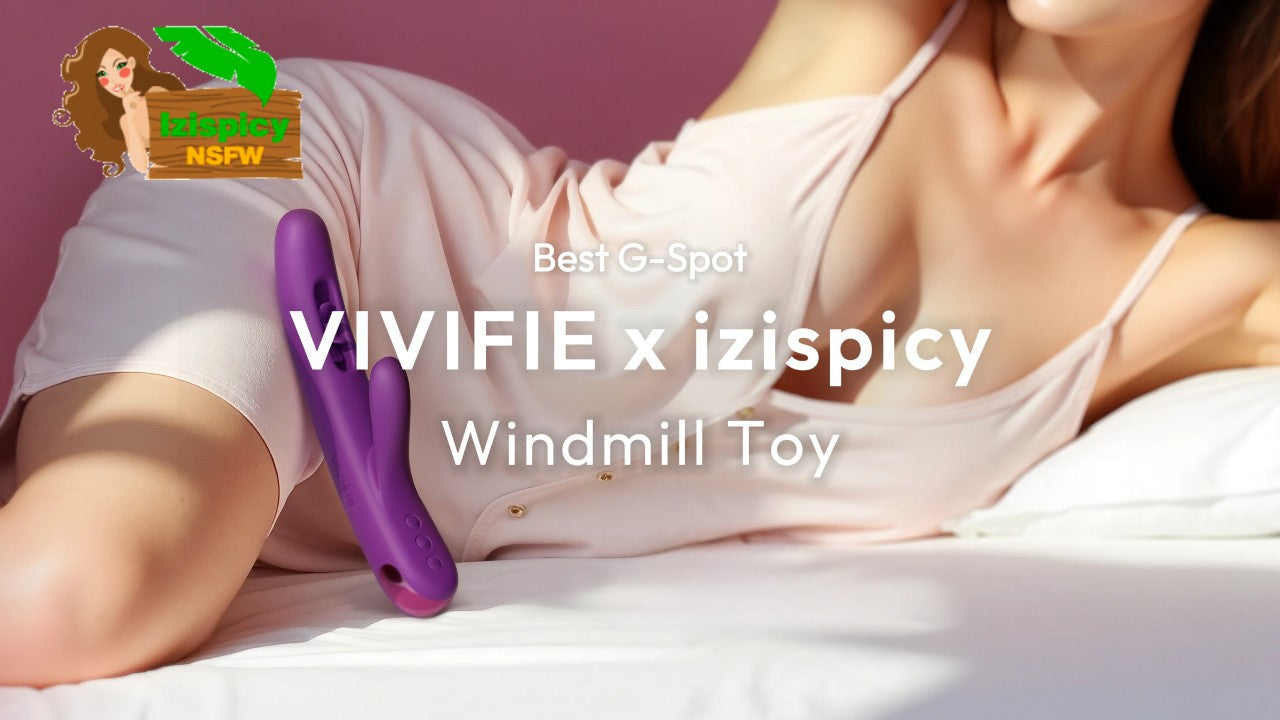How to Choose the Best G-Spot Vibrator in 2025 (Practical Buyer’s Guide)
Short on time? The right G-spot vibrator combines a curved shape, a focused tip, quiet power, and intuitive controls. In 2025, windmill-style designs that maintain steady contact are increasingly popular because they deliver targeted, repeatable pressure with less wrist work. This guide breaks down everything you need to know—shapes, sizes, motors, materials, noise, charging, hygiene, and value—so you can buy with confidence.
If you already want a proven, precision-focused pick, see our editor’s choice: VIVIFIE Vindani (Windmill G-Spot), or browse the Windmill Collection.
Table of Contents
- Understand the G-spot and why shape matters
- Design types in 2025: windmill vs. traditional
- Shape, size, and firmness: finding your fit
- Motor quality, noise, and vibration character
- Controls & usability: real-world ergonomics
- Materials, safety, and hygiene
- Battery, charging, and durability
- Choose by persona: beginner, sensitive, power-lover, explorer
- Budget guide and value checklist
- Quick comparison table
- How to use, adjust, and care for your toy
- Common mistakes and myths to avoid
- FAQs
- Editor’s Choice & where to buy
1) Understand the G-spot and Why Shape Matters
The G-spot is typically described as a sensitive area on the anterior (front) wall. People often respond best to pressure at a gentle upward/forward angle. That’s why G-spot toys are usually curved and have a focused tip or bulb—this combination makes it easier to keep steady contact while you explore angles and intensity.
Consistency matters: a toy that can hold contact with minimal micro-adjustments helps you map your personal “sweet spot.” For many users, that’s a slightly upward curve with enough firmness to apply pressure without feeling pokey or rigid.
2) Design Types in 2025: Windmill vs. Traditional
There are many G-spot designs, but two families dominate the 2025 conversation:

Windmill-Style (Circular Micro-Motion)
Windmill toys use a compact spinning module near the tip to produce circular pressure patterns. The benefit is steadier contact with the target area—even as angles shift slightly. Layered with vibration, this can feel intentional and controlled rather than surface-level. If you’ve struggled to keep a traditional toy “on spot,” windmill mechanics can reduce wrist work dramatically.
Traditional (Linear Vibration)
Classic rabbits, curved bullets, and wands rely on linear oscillation. They can be excellent for broad stimulation and intensity variety, but some users find them more angle-sensitive: the tip can bounce off the sweet spot during motion. If linear vibration works for you already, a refined, curved model with a focused tip might be all you need. If you want steadier pressure at lower intensities, consider windmill.
Hybrid designs exist too—some combine rotation, pulse, and pattern control. Evaluate whether these hybrid features actually help you maintain contact and comfort, rather than adding complexity you won’t use.
3) Shape, Size, and Firmness: Finding Your Fit
- Curve: A gentle upward curve (often ~20°–35°) is a friendly starting point for G-spot reach.
- Tip Geometry: A rounded bulb or a slightly tapered head helps apply pressure without sharp edges.
- Girth: Slim-to-medium works for most. Bigger isn’t automatically better for G-spot focus.
- Firmness: Too soft can collapse under pressure; too rigid can feel pokey. Balanced flexibility is ideal.
- Weight & Balance: A well-balanced handle reduces wrist strain, especially during longer sessions.
Size is personal. If you’re new, start slim-to-medium and focus on control and contact over size.
4) Motor Quality, Noise, and Vibration Character
In 2025, the conversation is less about “how strong” and more about how controlled. A great G-spot toy delivers power with low chatter and low noise, keeping the tip stable under pressure. Multi-motor architectures can distribute load more evenly and reduce rattle. Sound matters if you share a space; “whisper-quiet” marketing is common, but user reviews are the better gauge.
- Character: Deeper rumbles often feel more satisfying than high-pitched buzz for internal stimulation.
- Control: Independent control of windmill speed vs. vibration patterns is a plus.
- Stability: Good drivetrains do not stall or get noisy when you apply pressure.
5) Controls & Usability: Real-World Ergonomics
Great controls save you from breaking focus. Look for clearly differentiated buttons you can operate by feel, and a layout that separates windmill speed from vibration patterns if applicable. A travel lock keeps things discreet on the go; charge indicators that don’t shout in the dark are a thoughtful touch. If a toy has an app, consider whether you’ll realistically use it—or if on-device controls are already seamless for you.
6) Materials, Safety, and Hygiene
Body-safe, non-porous materials such as medical-grade silicone are the standard for a reason: they’re smooth, comfortable, and simple to clean. Check that seams are minimized and transitions are smooth. Pair silicone toys with water-based lubricants, and follow any care guidance in the manual. Water resistance (IPX ratings) simplifies cleaning; just confirm whether it’s splash-safe or fully submersible according to the manufacturer.
7) Battery, Charging, and Durability
- Battery Life: Multiple sessions per charge is ideal; consistent output matters more than peak specs.
- Charging: Magnetic or USB-C are convenient. Avoid exposed ports in splash-only designs.
- Durability: Look for thoughtful sealing, robust motor mounts, and warranty support.
A well-tuned toy should feel steady near the end of a charge, not weak or rattly. Longevity is partly about care: avoid extreme heat/cold and store the toy dry in a pouch.
8) Choose by Persona: Beginner, Sensitive, Power-Lover, Explorer
Beginner
Start with a slim-to-medium curved design, a rounded tip, and gradual intensity control. If maintaining angle is tricky, a windmill toy can help you keep contact with less effort. Prioritize quiet operation and intuitive buttons.
Sensitive
Look for lower starting intensity, fine-grained steps, and soft, smooth silicone. A well-tuned windmill mechanism at low speed may deliver satisfying pressure without overwhelming buzz.
Power-Lover
Seek deeper rumbles, solid motor stability under pressure, and longer battery life. Some users enjoy medium girth for pressure feedback; others prefer compact power with a focused tip.
Explorer
Consider designs that layer sensations (e.g., windmill + vibration) and allow independent control. Versatility keeps experimentation fresh without buying multiple devices immediately.
9) Budget Guide and Value Checklist
- Entry: Simple curved silicone toy, reliable motor, basic water resistance. Good for first-time mapping.
- Mid: Better drivetrains, quieter operation, refined ergonomics, independent control of functions.
- Premium: Advanced mechanics (e.g., windmill), triple-motor coordination, elegant finishing, discreet ownership details.
Value checklist: body-safe build, quiet and stable motor, ergonomic curve, focused tip, water resistance that matches your routine, clear controls, and responsive support.
10) Quick Comparison Table
| Criteria | Windmill-Style (e.g., VIVIFIE Vindani) | Traditional Curved/Rabbit |
|---|---|---|
| Targeting | Steady circular pressure on the G-spot | Linear buzz; can slip off target |
| Learning Curve | Intuitive; less wrist micromanagement | More angle sensitivity |
| Noise | Often quieter at useful intensities | Varies; can get louder under load |
| Comfort | Ergonomic curve + contact stability | Requires more repositioning |
| Efficiency | Effective at moderate speeds | Higher intensities often needed |
| Control | Independent windmill/vibration layers | Usually patterns + intensity only |
11) How to Use, Adjust, and Care for Your Toy
Setup & First Session
- Lube: Apply water-based lubricant to reduce friction and help the tip glide while keeping contact.
- Angle: Start with a gentle upward/forward tilt. Let the curve do the work—avoid wrist strain.
- Speed: Begin low. If you have a windmill toy, explore slow circular pressure first, then layer gentle vibration.
- Mapping: Spend a few short sessions identifying the angle and speed you prefer; note settings you can repeat.
Cleaning & Storage
- Clean before and after use with toy-safe cleanser or mild soap and water according to the manual.
- Fully dry and store in a breathable pouch, away from extreme temperatures and sunlight.
- Use only water-based lubricants with silicone toys.
Longevity
- Recharge before completely drained when possible.
- Engage the travel lock for transport.
- Follow any manufacturer guidance on charging cycles.

12) Common Mistakes and Myths to Avoid
- Myth: “Bigger is always better.” Targeted pressure and contact consistency matter more for G-spot stimulation.
- Mistake: Skipping lubricant. Lube improves comfort and helps maintain steady contact.
- Mistake: Chasing max intensity immediately. Many users respond better to moderate, controlled pressure first.
- Myth: “If one toy didn’t work, none will.” Small differences in curve, tip shape, and motion style can change everything.
- Mistake: Ignoring ergonomics. Poor balance or awkward buttons can break focus and shorten sessions.
13) FAQs
What shape works best?
A curved shaft with a rounded or focused tip helps apply pressure to the anterior wall and maintain contact. Medium firmness prevents collapse without feeling harsh.
Windmill vs. traditional—how do I decide?
If you’re tired of repositioning and want steady, guided pressure, try windmill. If you already love classic vibration and only need a better curve/tip, a traditional model may suit you fine.
How important is noise?
Very, if you care about privacy. Look for quiet operation that stays composed under pressure. Real-world reviews can be more revealing than spec sheets.
Is silicone always the best material?
Medical-grade silicone is the standard for comfort and hygiene. Pair it with water-based lubricants and follow the cleaning instructions.
Any beginner tips?
Start with low intensity, use lube, and explore short sessions over a few days to map your preferred angle and speed. Patience beats brute force.
14) Editor’s Choice & Where to Buy
If you want targeted, consistent G-spot stimulation with less wrist work, a windmill-style design is a 2025 standout. Our Editor’s Choice is VIVIFIE Vindani for its circular micro-motion, quiet multi-motor tuning, ergonomic curvature, and refined materials. You can also browse the full lineup here: VIVIFIE Windmill Collection.
Next step: choose the curve and control style that fit your routine, prioritize quiet stability over raw intensity, and invest in body-safe materials you’ll be comfortable using often. With the right match, consistency and comfort make all the difference.
About VIVIFIE: VIVIFIE is a modern intimacy brand focused on thoughtfully engineered pleasure technology. We design for deeper, safer, quieter experiences—through precision mechanics, elegant ergonomics, and body-safe materials.








